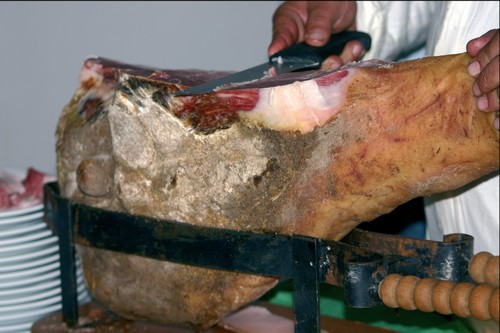Prodotti Tradizionali della Campania
PROSCIUTTO DI MONTE

In tutte le aree interne della regione, in particolare nel Matese, nel Sannio, in Irpinia e nel Bussento, viene prodotto il prosciutto detto “di Monte”, ottenuto sia dalle pregiate razze suine Landrace o Large White, sia da suini di tipo “Casertano”, alimentati con foraggi naturali come granoturco, crusca, patate, ghiande, castagne e altri vegetali. La mattazione avviene tra novembre e febbraio o, in ogni modo, quando la temperatura non raggiunge i 10 gradi. Dalla coscia posteriore del suino si ottiene il prosciutto grezzo, che viene salato, pressato e speziato. I locali utilizzati per l’essiccamento sono i sottotetti delle case, freschi e ventilati, con copertura costituita da tavole o canali di cotto, che facilita la naturale circolazione dell’aria e permette di ottenere le tipiche qualità organolettiche del prodotto, tenuto in questi ambienti fino a essiccamento ultimato, per essere poi trasferito nelle cantine. I prosciutti, durante l’intera fase di essiccamento, sono ricoperti da un sacchetto di stoffa sottile, che permette il passaggio dell’aria ma non quello degli insetti. A volte, per un breve periodo, si immette nei locali una piccola quantità di fumo, derivante dai camini utilizzati per il riscaldamento dei locali adibiti ad abitazione, che serve a migliorare la conservabilità del prodotto e a caratterizzarne il sapore.
![]() In
all the internal areas of the region, in particular in the Matese, Sannio,
Irpinia and Bussento, a ham called “di Monte” is produced.
It is obtained from the excellent Large White or Landrace pig races and
the “Casertano”, fed with natural forage like corn, bran,
potatoes, acorns, chestnuts and other vegetables. The butchering is performed
between November and February or when the temperature reaches 10C. The
raw ham is obtained from the rear leg of the pig. The meat is salted,
pressed and spiced. The ham is dried in the attics of the houses that
are fresh and ventilated and that are covered with boards, to facilitate
the natural circulation of the air and obtain the typical organoleptic
characteristics of the product. It is kept here until it is completely
dried and then transferred to cellars. During the whole drying phase
the hams are covered with sacs made of thin cloth that allow the passage
of air but not that of insects. Sometimes, just for a short time, a small
quantity of smoke from the chimneys used to warm the living quarters,
is allowed in the area and it helps improve the preserving qualities
of the product and further characterize its taste.
In
all the internal areas of the region, in particular in the Matese, Sannio,
Irpinia and Bussento, a ham called “di Monte” is produced.
It is obtained from the excellent Large White or Landrace pig races and
the “Casertano”, fed with natural forage like corn, bran,
potatoes, acorns, chestnuts and other vegetables. The butchering is performed
between November and February or when the temperature reaches 10C. The
raw ham is obtained from the rear leg of the pig. The meat is salted,
pressed and spiced. The ham is dried in the attics of the houses that
are fresh and ventilated and that are covered with boards, to facilitate
the natural circulation of the air and obtain the typical organoleptic
characteristics of the product. It is kept here until it is completely
dried and then transferred to cellars. During the whole drying phase
the hams are covered with sacs made of thin cloth that allow the passage
of air but not that of insects. Sometimes, just for a short time, a small
quantity of smoke from the chimneys used to warm the living quarters,
is allowed in the area and it helps improve the preserving qualities
of the product and further characterize its taste.